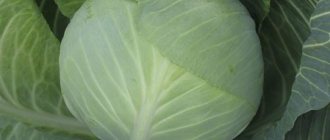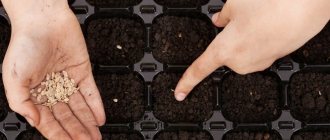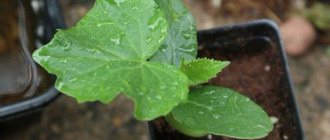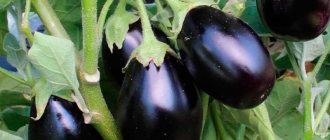Thanks to breeding work, new varieties are constantly appearing on the eggplant seed market. Eggplant varieties Valentina F1 were registered in Russia in 2007. They were bred by the Dutch company Monsanto. This hybrid, which is characterized by excellent taste, is gaining popularity among gardeners due to its early ripening period and resistance to viruses.
Hybrid characteristics
In the Russian climate, Valentina F1 eggplant is grown in greenhouses or under film covers. In the southern regions, bushes grow in open ground. Hybrid Valentina is noted for its resistance to weather changes. In unfavorable conditions, flowers stay on the plant, do not fall off, and ovaries and fruits are formed.
Cute dark purple long eggplant fruits with original pendants decorate the hybrid bush already on the 60-70th day after planting in the beds. The very first, large fruits can be picked in July. The crop ripens three months after germination. More than 3 kg of vegetables are harvested from one square meter of Valentina plantings. The fruits of the Valentina F1 eggplant are uniform and are famous for their excellent commercial properties.
The fruits can be stored for about a month in a cool room without losing their taste. Vegetables are used to prepare various dishes and preparations.
It is important to choose the moment of culinary ripeness of the eggplant. Usually by this time the fruits have a rich dark shade and a glossy cover. Vegetables with dull, slightly pale skin are overripe; small, hard seeds are already beginning to form.
Attention! Valentine's eggplant is a hybrid; it is not advisable to propagate it with personally collected seeds. New plants will not replicate the qualities of the mother plant.
Advantages and disadvantages of eggplant Valentine
Valentine eggplants are usually characterized by a number of advantages:
- early-bearing and productive (in open ground you can get up to 3.2 kg/m2);
- delicate and pleasant taste;
- attractive appearance and one-dimensionality of the fruit;
- small number of seeds;
- resistance to the vagaries of the weather, flowers do not fall off even under unfavorable conditions;
- high resistance to tobacco mosaic virus.
Some gardeners consider the shortcomings to be the small thickness of the fruit, and the taste seems ordinary to many (similar to the Almaz variety). There is an opinion that the quality of Valentina’s pulp is inferior to Bibo’s eggplant.
Description of the plant
Bushes of the Valentina variety are erect, vigorous, semi-spreading, rising to 0.8-0.9 m. The trunk of the plant is pubescent, distinguished by a faint light purple color. Medium-sized leaves of a rich green hue, notched along the edges. The flowers are large, white and purple.
Dark purple fruits are elongated, drop-shaped, can stretch up to 20-26 cm. The diameter of the thickened, lower part of the fruit is up to 5 cm, the upper part is up to 4 cm. The weight of the fruit reaches 200-250 g. The skin is glossy, thin, easy to peel . The dense flesh has a pleasant creamy white color. Descriptions of gardeners who grew this hybrid note a soft and delicate taste of the fruit, without a hint of bitterness.
Features of planting and growing the variety
It is recommended to grow eggplants using the seedling method. It allows you to get strong, viable plants and an early harvest - the first fruits are harvested in mid-summer.
Soil preparation
It is best to grow eggplant seedlings in a special soil mixture - it is sold in agro-shops. If desired, you can prepare the soil yourself.
To prepare the soil for seedlings, mix in equal parts:
- compost or humus;
- peat;
- sand;
- fine sawdust or perlite.
Add ash to the thoroughly mixed mixture - 1 cup per bucket, or saltpeter - 10 g. The soil is also enriched with urea - 1 tbsp is dissolved in 10 liters. l. fertilizers
Timing
The exact time to plant seeds depends on the growing region. When choosing a sowing date, take into account the time of planting and the duration of growing seedlings. From the moment of sowing to readiness, it takes about 2 months.
In regions with a temperate climate, sowing seeds for growing eggplant seedlings is carried out from the second half of February to mid-March.
Sowing seeds without germination
It is not necessary to germinate eggplant seeds. But they can be disinfected in hydrogen peroxide or a growth stimulant.
Eggplant seedlings are grown in separate containers. They do without picking, since the seedlings have a very delicate root system, and replanting harms them. Therefore, seeds are sown immediately in pots or cassettes, and not in large containers.
Seed sowing order:
- Fill the pots with the prepared mixture or purchased soil mixture. Do not compact the soil.
- Make small indentations in the center of the pot. Plant the seeds to a depth of 1-1.5 cm.
- Place only one seed in one hole.
- Water the crops and cover with soil.
- Cover the pots or cassettes with transparent material and place them in a warm, well-lit room.
- Maintain the temperature during the day at +26 to +28 °C, and at night at +15 to +16 °C.
Growing a hybrid
They begin sowing Valentina eggplant seeds from the beginning of March. Typically, Dutch seeds are sold already coated with special substances after pre-sowing treatment. But in the reviews of summer residents there are mentions that after soaking in growth stimulants, the seeds of the hybrid sprouted faster. Soaking in aloe juice for half a day also speeds up seed germination.
Then the seeds are dried and germinated.
- They are placed in wet wipes, cotton wool or hydrogel and left at a temperature of 25 0C;
- The germinated seeds of the hybrid are carefully transferred, with a piece of paper napkin or a grain of gel, into the soil of a peat pot or paper cup.
Sowing seeds without germination
For hybrid Valentine eggplants, you need to prepare nutritious soil. The soil is mixed equally with humus, peat, sawdust, enriching the composition with wood ash and urea. The solution is prepared in the proportion of 1 tablespoon of urea per 10 liters of water. Sand is added to clay soil.
- Eggplant seeds are deepened by 1-1.5 cm, the pots are covered with film or glass;
- The temperature for germination of seedlings should be at 25-26 0C;
- Sprouts appear after 10 days.
Warning! It is better to sow eggplant seeds immediately in separate containers, because their root system does not tolerate transplantation well.
Seedling care
During the first 15-20 days, young eggplant seedlings require the air to warm up to 26-28 0C. Then the temperature drops by one degree during the day, and at night it should be between 15-16 degrees. If the weather is cloudy, the daytime temperature should be maintained at 23-25 0C. At the same time, the seedlings of the Valentina hybrid must be illuminated for up to 10 hours.
- Water for watering plants is heated;
- The soil is moistened after drying;
- The drug “Kristalin” is used to feed plants. 6-8 g of fertilizer are dissolved in 5 liters of water.
Eggplants in greenhouses
Valentina eggplants are planted in unheated greenhouses and shelters in the second ten days of May. Make sure that the soil warms up to 14-16 0C. By this time, the seedlings have risen to 20-25 cm, 5-7 true leaves have been formed.
- When planting Valentina hybrid plants, adhere to the 60 cm x 40 cm scheme;
- Eggplant bushes should be watered with warm water 2-4 times a week. After watering, the soil around the plants is carefully loosened so as not to damage the roots;
- It is advisable to mulch the soil;
- The first feeding of plants is carried out 3 weeks after planting. Pour 1 tablespoon of Kemira Universal fertilizer into 10 liters of warm water. Water 0.5 liters at the root;
- Use mineral fertilizers of your choice or organic matter: wood ash, fermented infusion of meadow grasses and weeds, manure solution;
- At the end of July, all eggplant bushes are looked through to select the largest ovaries. They are left and others are removed, just like flowers. This is done so that the fruits ripen faster.
The greenhouse must be ventilated so that the eggplant bushes do not suffer from high temperatures. Due to their resistance, hybrid Valentina plants retain flowers and ovaries, but the fruits grow small.
Comment! You need to check the humidity level. The optimal figure is up to 70 percent. In a damp environment, pollen cannot move and the yield will be reduced.
Eggplants in the garden
Valentine's eggplants are brought to the garden at the end of May or beginning of June.
Choose a good sunny place where carrots, peas, beans, cabbage, greens or melons grew last year. These plants are considered the best predecessors for eggplants.
- When digging, the soil is enriched with superphosphate, potassium sulfate, and ash. Or add humus or compost;
- Add sand to clay soil in large holes. Eggplants develop better on light but fertile soils;
- Before planting, fertilizers such as “Growth”, “Agro-growth”, “Kemira universal” and others are applied to the soil according to choice, checking the instructions;
- Distance between rows: 60-70 cm, between plants: 25-30 cm;
- For the first 7-10 days, Valentina eggplant seedlings need to be shaded if the weather is hot and cloudless. In addition to spunbond, they take spacious cardboard boxes, dismantling the bottom plane, old buckets without bottoms and other available materials;
- The plants are watered with water that has warmed up during the day, and in the morning the soil is loosened and mulched.
Planting eggplants in open ground
15-20 days before transplanting into open ground, seedlings need to be hardened off. To do this, take it out into the fresh air for several hours every day - this way the eggplants will experience minimal stress and take root faster.
Features of growing Valentina eggplants in open ground:
- Seedlings can be transplanted after they reach 18-20 cm in height and acquire 5-7 true leaves.
- It is best to plant eggplants in beds after carrots, beans, peas, melons or watermelons.
- The soil for planting crops should warm up to +15°.
- The depth of the eggplant hole should be 18-20 cm.
- Pour 2 cups of heated water into each hole, place the seedling inside along with a ball of earth and lightly sprinkle with soil.
- Compact the soil well and water with 2-3 glasses of warm water.
When planting eggplants of the Valentina variety, make sure that the distance between the bushes is at least 35-40 cm, and the row spacing is up to 50-60 cm.
Secrets of vegetable growers
Hybrid eggplants Valentina are an unpretentious and sustainable crop. But you should know the accumulated experience of gardeners who have grown plants of this species in order to get a good harvest.
- After transplanting into the greenhouse, the plants are watered for the first time after 5 days;
- You need to pour 0.5-1 liters of water under the hybrid bush so that the moisture reaches all the roots of the plant;
- Warm water is poured under the root of the plant;
- Loosening should be superficial;
- For normal growing season, plants require heat up to 28-30 degrees;
- When the buds begin to form, the eggplants are fertilized: 30-35 g of ammonium nitrate and 25 g of potassium sulfate are diluted in 10 liters. Each plant receives at least 0.5 liters of solution;
- During the formation of ovaries, nitrogen-phosphorus fertilizers are applied to the area with eggplants in the following proportions: 10 liters of water: 25 g of superphosphate: 25 g of potassium salt.
Advice! It is necessary to feed mullein infusion in small doses so that the leaf mass of the plant does not increase to the detriment of the fruits.
Harvesting and application
Eggplants begin to be collected as needed from the end of July. Mass collection is carried out with the onset of cold weather or when diseases appear.
Vegetables are used both fresh and for hot dishes. There are many vegetable and meat dishes with eggplants. They are used to make caviar, various salads, pickle and salt.
Hybrid Valentina F1 tolerates transportation and is shelf-stable in cool conditions - more than 1 month without loss of taste.
How to protect eggplants
High humidity can cause fungal diseases in eggplants.
- The preparations “Anthracnol” and “Quadris” will protect plants from late blight;
- "Horus" - from gray rot;
- For prevention, Valentina eggplant bushes are treated with Zircon or Fitosporin.
Plant pests: Colorado potato beetles, spider mites, aphids and slugs.
- In a small area, beetles are collected by hand;
- Insecticide "Strela" is used against ticks and aphids;
- Slugs leave if the soil is sprinkled with ash.
Labor in the eggplant bed will bear fruit in mid-summer.
Vegetables will be a tasty addition to the table.
Reviews
Gardeners growing Valentina f1 eggplant unanimously note its resistance to weather conditions and high yield.
Valentina, Yaroslavl region: “We plant these eggplants every year. Thanks to early ripening, there is always a harvest, even in cold summer conditions. I can recommend this hybrid to everyone."
Natalya, Moscow region, Ozyory: “I like the Valentina F1 hybrid, we plant it all the time. The fruits are large, tasty, and not bitter. It can sit for a long time without spoiling, it’s good for preparations.”
Andrey, Kirov: “We live in a region with risky farming conditions; we have frosts even in June. We plant the hybrid later than indicated in the instructions, but it has time to ripen. Other varieties had to be picked unripe. I consider the Valentina hybrid one of the best for growing in the northern regions."
Seedling care
Eggplant crops require daily care - it is necessary to maintain air temperature, soil moisture, feed the grown seedlings in a timely manner, and ensure the correct lighting conditions.
Temperature
When growing any seedlings, including eggplant, the ambient temperature changes depending on age.
Features of temperature conditions:
- For 14-15 days after sowing, maintain the temperature at +26 ... +28 °C.
- When shoots appear, the film or glass is removed, the pots with seedlings are placed closer to the light, and the temperature is reduced to +23...+25 °C. This limitation helps to avoid stretching of seedlings.
- Night temperatures should be +15…+16 °C.
- On cloudy days, it is recommended to lower the daytime temperature by 2–3 °C.
Daylight hours
Seedlings need long daylight hours. If there is not enough sun, additional artificial lighting is used.
Features of the light mode:
- For lighting, it is advisable to install special phytolamps with a red-blue light spectrum, which is favorable for plants. With such lamps, seedlings can be grown even in dimly lit rooms.
- Daylight hours should be 10 hours.
Watering
Seedlings need regular moisture. The main principle of irrigating seedlings is regularity, which should take into account the condition of the soil.
Watering rules:
- water for irrigation should be heated to +20 °C;
- the soil is moistened as it dries, the average frequency of watering is once every 2 days;
- An excess of moisture is not allowed - the seedlings may get blackleg.
During watering, it is recommended to use antifungal drugs - “Fundazol” or “Gauspin”.
Top dressing
If seedlings are grown in fertile, well-fertilized soil mixture, then you can do without fertilizing. Otherwise, the seedlings will have to be fed.
How to feed seedlings:
- Water with Kristalina solution 2-3 times. To prepare the solution, dilute 6-8 g of the drug in 10 liters of water.
- Dilute 30 g of superphosphate and 10 g of urea in a bucket of water, and pour the prepared solution over the seedlings.
Transplanting seedlings
2 weeks before planting seedlings in open ground, the seedlings begin to harden and are taken outside. First for 20 minutes, then every day the duration of the “walks” is increased, gradually reaching several hours.
Hardening is necessary for plants to improve adaptation to new conditions - sunlight and sudden temperature changes.
Seedlings ready for transplanting must have at least 5 true leaves. The height of the seedlings is 20-25 cm. Another sign of seedling readiness is the appearance of buds.
The procedure for transplanting seedlings into the ground:
- Prepare the landing site. This should be a well-lit area in which legumes or melons grew. Dig it up and fertilize it with superphosphate (30-50 g per 1 sq. m), wood ash (1 cup per 1 sq. m) and potassium sulfate (15-20 g per 1 sq. m).
- Dig holes for seedlings at intervals of 25-30 cm. If the soil is clayey, add a handful of sand to the holes. There should be a distance of 60-70 cm between adjacent rows. The depth of the holes is 15 cm.
- Before planting, water the holes with water - approximately 500 ml per hole.
- Place the seedling in the hole. Deepen it to the cotyledon leaves, sprinkle with soil and lightly compact it.
- Water the plants again and mulch with dry grass or pine needles. Instead of natural mulch, you can use dark film - it is laid between the rows.
It is recommended to transplant eggplants into open ground in the evening in calm weather.
In order not to provoke excessive growth of green mass, it is necessary to follow the dosage when feeding eggplants with mullein infusion. No more than 500 ml of solution is poured under one bush (200 ml of mullein infusion is diluted in 10 liters of water).
How to grow your own
Eggplant has a long growing season, so it is grown through seedlings. The sowing time for planting in a greenhouse is the second or third decade of February, for open ground - early March.
Growing seedlings
The largest seeds are selected. Disinfect planting material in a solution of potassium permanganate or Fitosporin. The seeds of Dutch hybrids are sold already processed, but some gardeners soak them in a biostimulant, for example, Heteroauxin, to improve germination.
The method of seed germination is often used. To do this, they are kept moist at a temperature of +25...+27 °C until sprouts appear.
You can prepare the soil for sowing yourself or purchase it ready-made in the store. Soil composition:
- turf land - 10%;
- humus - 20%;
- peat - 60%;
- sand or sawdust - 10%.
Attention! Any soil should be disinfected before use.
Eggplants do not tolerate picking well, so it is recommended to sow the sprouted seeds in small pots, and then, as they grow, transfer them with a lump of earth into a container of a larger diameter.
Vip magic || Vip magic || Full moon fortune telling: types, rules and interpretation
The seeds are sown to a depth of 1 cm, covered with glass or film on top and placed in a warm place with a temperature of about +25 °C.
After the shoots emerge, the film is removed and the pots with seedlings are placed in a bright place. Since the crop is sown in winter, additional lighting has a beneficial effect on the development of seedlings.
Feeding eggplant seedlings is required only if humus was not used during planting. If the soil is fertile enough, you don’t need to feed the seedlings before planting them in the ground.
Transfer
Two weeks before transplanting, young plants must be hardened off, starting with a few hours and gradually leaving them in the fresh air for a longer time. Hardening helps plants adapt to sunlight and daily temperature changes.
Seedlings ready for planting have a thick stem and at least five true leaves. The seedlings must be more than two but less than three months old. A sign that seedlings are ready for transplanting is the appearance of the first buds.
Growing eggplants in open ground can only be done by experienced gardeners. Usually this crop is planted in greenhouses or greenhouses.
The required soil temperature for planting this heat-loving plant is considered to be +19…+20 °C, which is problematic for open ground.
In the greenhouse, holes are prepared for planting eggplants at a distance of 50 cm; a handful of wood ash is placed in each hole. Before planting, the hole is spilled with water, the seedling is deepened to the cotyledon and the soil around it is lightly compacted.
Reference. Bell peppers, green crops and legumes will be good neighbors for the vegetable.
Further care
Temperatures considered favorable for growth and fruit set are +25..+28 °C . At temperatures below +15 °C, the plant stops growing, and when overheated above +35 °C, the pollen becomes sterile and fruits are not set. Adjust the temperature by airing, making sure that there are no drafts, which eggplant cannot tolerate.
When watering, moisten the soil to a depth of at least 20 cm. During the growing season, water once a week, and during the fruiting period - twice a week. Watering should be done with warm, settled water.
The row spacing is loosened no deeper than 3–5 cm, so as not to damage the delicate roots of the plant.
During the season, the crop should be fed 3-4 times. During growth, they are fed with complex fertilizers. During the period of fruit formation and growth, eggplant requires a lot of potassium. Phosphorus-potassium fertilizers are suitable.
Features of cultivation and possible difficulties
The peculiarity of growing eggplants is an indispensable condition for early sowing of seedlings.
Features of watering: eggplants are moisture-loving plants, but do not tolerate stagnant water.
When planting in a greenhouse, it is not advisable to plant eggplants together with tomatoes, since nightshade diseases easily spread to these delicate plants.
Important! The lack of fertilizing negatively affects the development of the bush and fruiting.
Experts recommend forming a bush: combating excessive foliage, removing excess shoots, especially from the lower part of the plants.
Diseases and pests
Eggplants are susceptible to many viral and bacterial diseases, and their delicate foliage suffers from pests.
Eggplant diseases:
- Black bacterial spot. Black spots with a yellow border appear on the leaves, and lesions with ulcers appear on the fruits. Fitoflavin-300 is used for treatment.
- Late blight. Brown spots first appear on the leaves, then spread to the stems and fruits, and the plant dies. A control measure is to spray plants with copper-containing fungicides.
- Gray rot (Alternaria blight). With high humidity in the greenhouse, gray wet spots appear on the leaves. They are controlled with contact fungicides, carefully spraying the lower leaves.
Eggplant pests:
- Whitefly . The 5mm white butterfly can cause damage when grown in a greenhouse. The plants are sprayed with the drug "Aktara" and watered at the root. Other drugs containing avermectins are also used.
- Spider mite. If the pest is small, it is enough to tear off the web and remove the damaged parts. Spraying with ammonia solution also helps.
- Colorado beetle. The preparations used are “Corado” 1 ml per 5 liters of water, “Aktara” 2 g per 10 liters of water, beetles are collected manually.
- Aphid. To combat, use solutions of laundry soap and ash, spraying the plants several times. In case of massive damage, the drugs “Strela”, Iskra”, etc. are used.
Video
The video looks at the formation of the Valentine bush.
Eggplant Valentine does not have too high resistance to common diseases, therefore, according to experienced vegetable producers, it is necessary to strictly follow the scheme of preventive measures, using “Antrakolom” or “Quadricis” for effective protection against late blight, as well as “Horus” for gray rot. Adherence to growing technology reduces the need for chemicals and produces better yields.
Advice from professionals
- The best soil for eggplants will be a mixture of peat, compost, rotted manure and sand with the soil of your region.
- To increase productivity, the soil after planting is fertilized with a mixture of ash and urea (1 tsp per 5 liters of water) and potassium sulfate (1 tsp per 5 liters of water).
- You cannot fertilize eggplants with fresh manure, as this can damage the root system of the bush.
- Young bushes should be planted at a distance of 40 cm from each other along the row, and 50 cm relative to the rows.
- If eggplants are planted in clay soil, then coarse sand must be added to the soil.
Valentina eggplants are planted in peat pots in March
Diseases and pests
Under unfavorable growing conditions and lack of prevention, even a resistant hybrid can be affected by diseases (viral and bacterial) and pests.
Possible diseases of the Valentina hybrid:
- Late blight. Accompanied by the appearance of brown spots on the leaves. Over time, the spots spread to shoots and fruits. The plant dies. To prevent the disease, eggplants are sprayed with fungicides containing copper - Bordeaux mixture, copper sulfate, copper oxychloride and others.
- Black bacterial spot. Symptoms are the appearance of black spots with a yellow border. The fruits become covered with ulcers. Plants are treated by spraying with Phytoflavin-300.
- Gray rot. Appears at high humidity. The leaves are covered with gray spots. Spraying with Horus helps get rid of the disease.
The most dangerous pests:
- Whitefly. Small butterflies whose larvae suck the juices from the plant. It is recommended to water the roots with Aktara.
- Aphid. Spraying with a solution of ash and laundry soap helps get rid of it. Several treatments are required. In case of mass destruction, use “Iskra”, “Strela”, etc.
- Colorado beetle. Spraying with Corado and Aktara preparations is recommended. You can collect beetles with your hands.
- Spider mite. If there are a small number of pests, the web and damaged parts of the plants are torn off. Spraying with ammonia solution is recommended.











